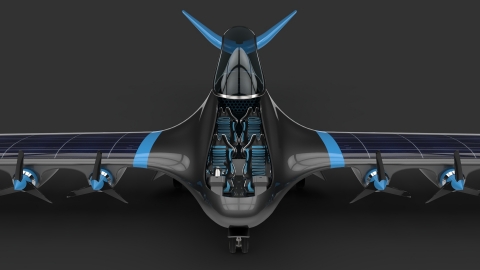Singapore’s HES onthult plannen voor regionale waterstof-elektrisch aangedreven passagiersvliegtuigen
SINGAPORE & PARIJS –(BUSINESS WIRE)– Na 12 jaar ontwikkeling van waterstofaandrijvingssystemen voor kleine onbemande vliegtuigen, onthult HES Energy Systems vandaag zijn plannen voor Element One, het eerste regionale waterstofelektrische passagiersvliegtuig ter wereld.
Dit persbericht bevat multimedia. Bekijk hier het volledige persbericht: https://www.businesswire.com/news/home/20181001006075/en/
Een eeuw na de start van de commerciële luchtvaart bundelt HES zijn krachten met een verscheidenheid aan partners om te pionieren aan een nieuwe vorm van luchtmobiliteit: stil en CO2-vrij, gepersonaliseerd, on-demand, gedecentraliseerd en economisch inclusief plattelandsgemeenschappen.
Singapore’s HES Unveils Plans for Regional Hydrogen-Electric Passenger Aircraft
SINGAPORE & PARIS–(BUSINESS WIRE)– After 12 years developing hydrogen propulsion systems for small unmanned aircraft, HES Energy Systems is today unveiling its plans for Element One, the world’s first regional hydrogen-electric passenger aircraft.
This press release features multimedia. View the full release here: https://www.businesswire.com/news/home/20181001006075/en/

ELEMENT ONE is a zero-emission, long-range electric aircraft powered by distributed hydrogen-electric propulsion. (Photo: Business Wire) (Photo: Business Wire)
One century after the start of commercial aviation, HES is joining forces with a variety of partners to pioneer a new form of aerial mobility: quiet and zero carbon, personalized, on-demand, decentralized and economically inclusive of rural communities.
Designed as a zero-emissions aircraft, Element One merges HES’ ultra-light hydrogen fuel cell technologies with a distributed electric aircraft propulsion design. With virtually no change to its current drone-scale systems, HES’ distributed system allows for modularity and increased safety through multiple system redundancies.
Element One is designed to fly 4 passengers for 500 km to 5000 km depending on whether hydrogen is stored in gaseous or liquid form. This performance is several orders of magnitude better than any battery-electric aircraft attempt so far, opening new aerial routes between smaller towns and rural areas using an existing and dense network of small-scale airports and aerodromes.
Originally from Singapore, HES has been working with a number of fast-moving start-ups and SMEs in France over the past year and exploring various locations to execute its Element One vision, including Aerospace Valley, the global aviation R&D hub located in Toulouse. Its parent company H3 Dynamics has been a symbol of intensifying technological cooperation between the two countries as part of the 2018 Year of Innovation.
The promise of hydrogen-electric power could shape the future of aviation. “It’s now possible to break past the endurance limits of battery-electric flight using HES’ ultra-light hydrogen energy storage in a distributed propulsion arrangement,” says Taras Wankewycz, founder of HES. “Element One’s design paves the way for renewable hydrogen as a long-range fuel for electric aviation.”
Refueling Element One will take no more than 10 minutes using an automated nacelle swap system that applies AGVs and automated warehouse operations such as those used by Amazon and Alibaba.
Last week, HES announced its plans to begin associating on-site hydrogen generation with fuel cell powered unmanned aircraft across a network of hydrogen-ready airports, in preparation for larger-scale electric aircraft such as Element One. HES is now in discussion with industrial-scale hydrogen producers to explore energy-efficient refueling systems using renewable solar or wind energy produced locally.
In an effort to explore new business models that help position Element One into new travel segments, HES has aligned its zero-carbon aviation roadmap with Wingly, a French startup that offers flight sharing services for decentralized and regional air travel: “We analyzed the millions of destination searches made by the community of 200,000 pilots and passengers on our platform and confirm there is a tremendous need for inter-regional transport between secondary cities,” says Emeric de Waziers, CEO of Wingly. “By combining autonomous emission free aircraft such as Element One, digital community-based platforms like Wingly and the existing high density network of airfields, we can change the paradigm. France alone offers a network of more than 450 airfields but only 10% of these are connected by regular airlines. We will simply connect the remaining 90%.”
Targeting a first flying prototype before 2025, HES is in the process of building a technical and commercial consortium involving both the aviation and hydrogen eco-systems.
About HES Energy Systems (Singapore)
HES Energy Systems specializes in building high performance hydrogen fuel cell systems to extend the flying range of autonomous aerial vehicles. With a presence in Singapore since 2009, HES has grown to become a global leader in developing ultra-light fuel cells and hydrogen energy storage systems. Hired by tier-one UAV manufacturers and leading aerospace institutes around the world for over 12 years, HES has developed a variety of hydrogen storage approaches to continuously push the limits of on-board, off-grid or portable energy. HES’ parent company H3 Dynamics Holdings is backed by Japan’s SPARX representing Toyota Mirai Creation Fund, ACA Partners, and Capital Management Group.
View source version on businesswire.com: https://www.businesswire.com/news/home/20181001006075/en/
Contacts
HES Energy Systems Pte. Ltd.
Bertrand Gauthier
Office: (+33) 6 63 00 50 64
Bertrand@hes.sg
